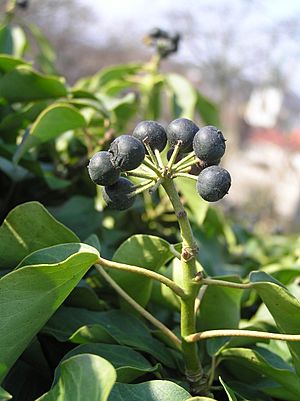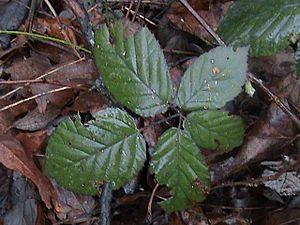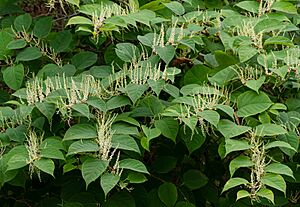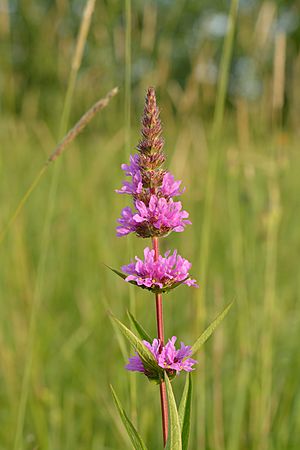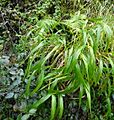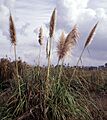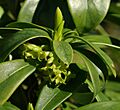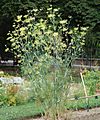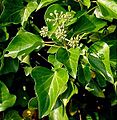List of invasive plant species in Oregon facts for kids
Invasive plants are a big problem in Oregon. These are plants that were brought to Oregon from other places, and they have spread so much that they are now harming the local environment. They can take over areas, pushing out the native plants that naturally grow there. This can cause big problems for the animals that depend on those native plants for food and shelter.
Contents
What are Invasive Plants?
When we talk about plants, there are two important terms to know:
- Introduced species: These are plants that have been brought to a new area, either on purpose or by accident. Many plants are introduced for gardens or farms, and they stay where they are planted.
- Invasive species: These are a special kind of introduced plant. They spread very quickly and aggressively, often taking over new areas. They can cause harm to the environment, the economy, or even human health. Think of them like bullies in the plant world!
In Oregon, many plants that were once introduced have now become invasive. They grow fast, produce lots of seeds, and can survive in many different conditions, making them very hard to control.
Why are Invasive Plants a Problem?
Invasive plants can cause a lot of trouble for Oregon's natural spaces:
- Harm to native plants: Invasive plants compete with native plants for sunlight, water, and nutrients. They often win this competition, causing native plants to die off.
- Impact on wildlife: Many animals, like insects, birds, and mammals, rely on specific native plants for their food and homes. When invasive plants take over, these animals lose their food sources and habitats, which can hurt their populations.
- Changes to ecosystems: Invasive plants can change the soil, how often fires happen, or even how water flows in an area. This can completely change an ecosystem, making it less healthy.
- Economic costs: It costs a lot of money to try and control invasive plants. Farmers might also lose crops if invasive weeds take over their fields.
Common Invasive Plants in Oregon
Oregon is home to many different invasive plants. Here are a few examples that you might see:
Tree of Heaven
The tree of heaven is a fast-growing tree that was brought to the United States from China in the late 1700s. It was first used as an ornamental tree in gardens. However, it quickly escaped cultivation and started spreading. This tree can grow almost anywhere, even in cracks in sidewalks or along roadsides. It produces many seeds and can also spread through its roots, forming dense groves that push out other plants.
Common Ivy
Common ivy is a popular plant often used in gardens for ground cover or to climb walls. It comes from Europe and Asia. While it looks nice in a garden, it can be very invasive when it escapes into natural areas. It climbs up trees, blocking sunlight from their leaves and sometimes even making them fall over. It also forms a thick mat on the ground, stopping other plants from growing.
Himalayan Blackberry
The Himalayan blackberry is a very common sight in Oregon. It was brought from Armenia in the late 1800s for its tasty berries. However, it has become one of the most widespread invasive plants in the state. It forms dense, thorny thickets that are almost impossible to walk through. These thickets take over fields, stream banks, and forests, making it hard for native plants and animals to thrive.
Japanese Knotweed
Japanese knotweed is a tall, bamboo-like plant that came from East Asia. It was brought to the U.S. in the late 1800s as an ornamental plant. It grows incredibly fast and can form dense stands that block out all other vegetation. Its strong roots can even damage foundations and pavement! It's very difficult to get rid of once it takes hold.
Purple Loosestrife
Purple loosestrife is a beautiful plant with bright purple flowers that came from Europe and Asia. It was introduced in the 1800s, likely through ship ballast or as an ornamental plant. It loves wet areas like wetlands, marshes, and riverbanks. When it invades these areas, it can quickly take over, reducing the habitat for native wetland plants and animals, including ducks and muskrats.
What Can You Do?
It's important to help stop the spread of invasive plants. Here are some ways you can help:
- Learn to identify them: Knowing what invasive plants look like is the first step.
- Plant native species: When you're planting a garden, choose plants that are native to Oregon. They are better for the local environment and don't become invasive.
- Clean your gear: If you're hiking or biking, make sure to clean your shoes, clothes, and bike tires to avoid spreading seeds to new areas.
- Volunteer: Many local groups organize events to remove invasive plants. This is a great way to get involved and make a difference!
By understanding and taking action against invasive plants, we can help protect Oregon's beautiful natural landscapes for everyone to enjoy.
Images for kids
See also
- Invasive species in the United States



